When the topic comes to operations, of course, all patients are interested in how long it will take for the stitch to heal and the process of restoring the body as a whole. Often women go to the hospital with a complaint that the suture hurts after laparoscopy. Unpleasant sensations such as itching, redness, and the appearance of compactions in the suture area may indicate the occurrence of an inflammatory process, which is not the norm. So what are the causes of pain in the suture area after laparoscopy?
1. Thread rejection (ligature fistula)
Sometimes it happens that after surgery, inflammation appears at the site of sutures, accompanied by serous and purulent discharge. All this indicates that a fistula has formed, as a result of which the body has started the process of rejecting the surgical threads. Naturally, if after laparoscopy the suture hurts, this is not the norm, and then there is a need to seek help from specialists.
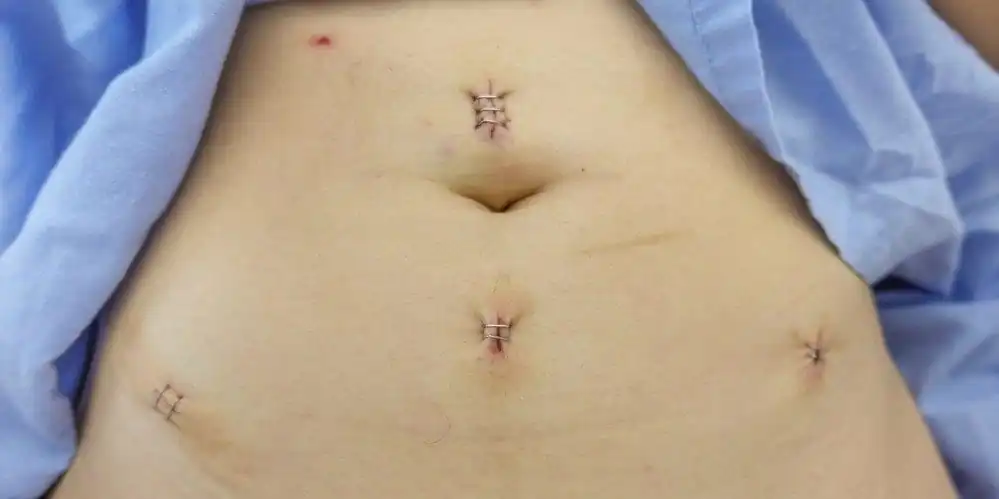
Causes of ligature fistula after laparoscopy:
- infection entering the seam through injured tissue due to non-compliance with hygiene rules;
- allergy to the material from which the threads are made.
In addition, the following factors can cause a fistula::
- the patient's unsatisfactory health condition;
- high level of immune reactivity of the body (observed at a young age);
- the presence of other specific infectious diseases (syphilis, tuberculosis and others);
- place and type of surgical procedures (surgery on the ovary, cyst removal);
- the presence of cancer that weakens the body’s protective functions;
- vitamin deficiency;
- diseases leading to metabolic disorders (diabetes mellitus, excess body weight).
- formation of compactions in the first days after laparoscopy;
- heat;
- swelling in the suture area;
- the seam hurts;
- release of fluid when pressing on the seam.
First of all, local antiseptics can be prescribed to relieve inflammation (ointments, medicinal powders), antibiotics (if the wound does not heal for a long time), as well as enzymes that help dissolve dead tissue. In addition, physiotherapeutic procedures (UHF therapy, quartz treatment) show positive results. If local therapy does not completely relieve inflammation, another operation (laparoscopy) will be required, after which local therapy will be performed again.
2. Seams coming apart
Postoperative sutures often cause a lot of inconvenience (for example, if the umbilical suture hurts after laparoscopy) and can cause the development of inflammatory processes. There are rare cases when the internal seams come apart, and in such a situation you should not think long about what to do, but rather seek help from a specialist as quickly as possible.
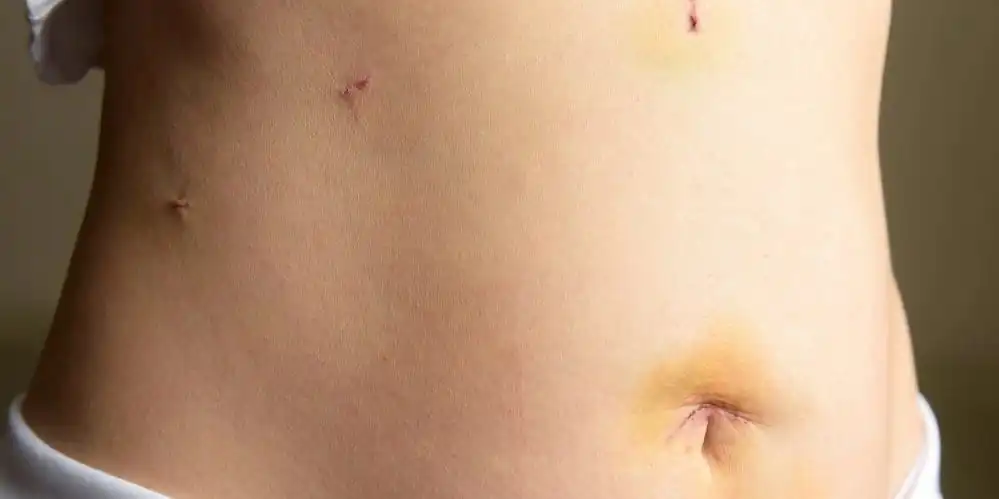
Causes of seam divergence:
- non-compliance with rest after surgery;
- sudden movements;
- carrying heavy loads;
- infections entering the wound;
- neglect of hygiene rules.
Symptoms of suture dehiscence after laparoscopy:
- pain when pressing on the seam;
- the appearance of liquid or purulent discharge when pressed;
- swelling and redness of the area around the suture;
- heat.
Undoubtedly, there is no other option than re-suturing. If the suture is already damaged, then for the normal course of the regeneration process of tissues injured after laparoscopy, the suture must be restored in order to avoid the risk of infections entering the open wound. In addition, when the suture is healed, it forms unaesthetic scars, which is an unfavorable indicator for most women.
After re-suturing, the pain from laparoscopy should go away, but it is important to follow all the doctor’s recommendations for caring for the suture. Therapy in this case does not present any difficulties: it consists of systematically treating the seam with antiseptic agents to eliminate the risk of infection. In addition, later you can resort to the help of wound healing agents (ointments), which can reduce tissue scarring.
3. Adhesions after laparoscopy
Adhesions are compactions that are formed from connective cells. They help unite internal tissues. This process is contradictory for the human body. Adhesions that appear after laparoscopy look like white stripes, which lead to deviations in the functioning of body systems, depending on where they are formed. The appearance of adhesions in a woman’s body, especially in the pelvic organs, creates a lot of health difficulties.
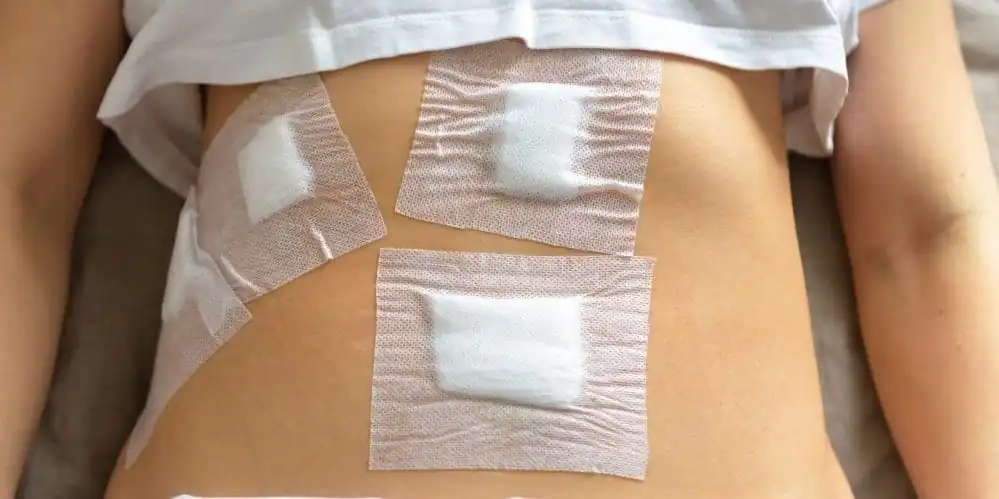
Reasons for the formation of adhesions:
- diabetes mellitus (due to reduced regenerative capacity of the body);
- connection with gas compositions used during surgical operations and the air environment (due to drying of tissues);
- excess body weight (excess fat tissue causes fusion in the abdomen and navel);
- infections (due to the appearance of the inflammatory process, tissue regeneration processes are hampered and compactions form).
Symptoms of adhesions are very limited. Their presence can only be detected by inspection and pulping, when small compactions are felt. The only symptom that may appear is if the stitches hurt for a long time (more than a month).
As a rule, physiotherapeutic procedures and medications are prescribed to treat adhesions. If a positive result cannot be achieved with local treatment, relaparoscopy can be performed (repeated surgery to remove adhesive formations, which is carried out by cauterizing them).
4. Inflammation of sutures after laparoscopy
Inflammation of sutures is not the worst ailment if you promptly seek the help of a specialist. After determining the cause that led to the inflammatory process, the most appropriate method of removing it and restoring the source of inflammation can be selected.
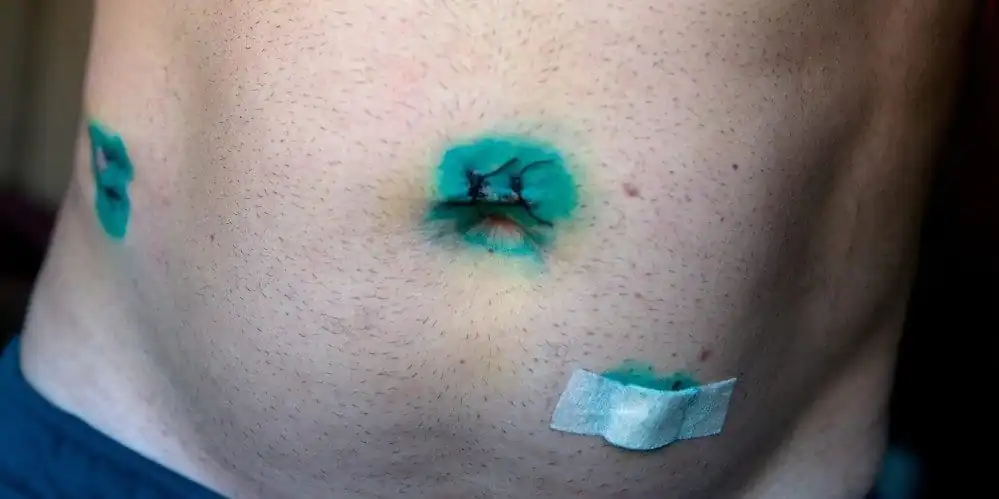
Causes of suture inflammation:
- weak immunity;
- entry of bacteria and viruses;
- non-compliance with hygiene and suture care;
- divergence of seams.
Symptoms of suture inflammation after laparoscopy are reduced to pain in the wound area, increased body temperature, and possible discharge from the suture. General malaise and chills may also occur.
Treatment of suture inflammation involves eliminating the root cause of the development of the inflammatory process and prescribing local therapy to relieve pain after laparoscopy: solutions for treating the suture and ointments with antibiotics.
5. Traumatization of the subcutaneous fat layer
Under certain circumstances, during the operation, the doctor may injure the subcutaneous fat layer, which does not always occur due to his incompetence. Sometimes it is simply not possible to sew up a wound any other way. This occurs when there is a process of tissue necrosis after laparoscopy.
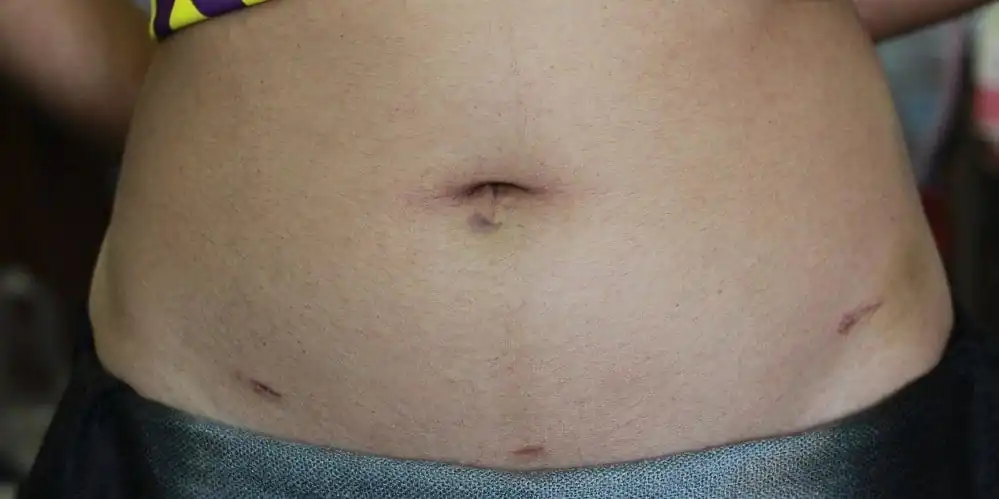
The most striking sign that tissue trauma has occurred during laparoscopy is the formation of a hematoma in the suture area. It also provokes pain.
Therapy for this disease consists of local treatment, and physiotherapeutic procedures can also have a positive effect on relieving inflammation.
Which doctor should I contact?
In the postoperative period (after laparoscopy), the suture needs careful care and treatment. But there are situations that even with full compliance with the doctor’s recommendations for treating the seam, for one reason or another, an inflammatory process may begin, which is always accompanied by painful sensations. A qualified surgeon will be able to help you understand this problem, who will determine the possible reason why the postoperative suture hurts and suggest the most effective ways to eliminate it.
Other causes of pain in the suture area after laparoscopy
- If the sutures after laparoscopy take a long time to heal and severe itching does not go away during the entire healing period, then this may indicate a poor-quality thread used during the operation. All this provokes unpleasant sensations in the area of the seam, and can even cause the development of inflammatory processes.
- There are situations when, for one reason or another, the threads of the internal suture do not dissolve. This may be caused by an allergic reaction to the material of the threads and the functional characteristics of the body. In this case, the tissues begin to reject the foreign body (threads), as a result of which the process of rotting and divergence of the suture placed after laparoscopy may begin. Of course, all these factors cause such an unpleasant symptom as stitches hurting after laparoscopy. In this case, the patient’s temperature may rise and general health may deteriorate.
- If the suture looks like an inflamed, swollen wound, then this is a sign of a medical error. That is, most likely, due to the incompetence of the surgeon, the suture was performed incorrectly, which stopped the processes of tissue regeneration and provoked inflammatory processes.
In this case, only a qualified specialist can eliminate the pain in the sutures, who will prescribe the most appropriate treatment to relieve inflammation and increase regenerative functions. In addition, improper treatment of the seam with antiseptic agents can lead to this condition.
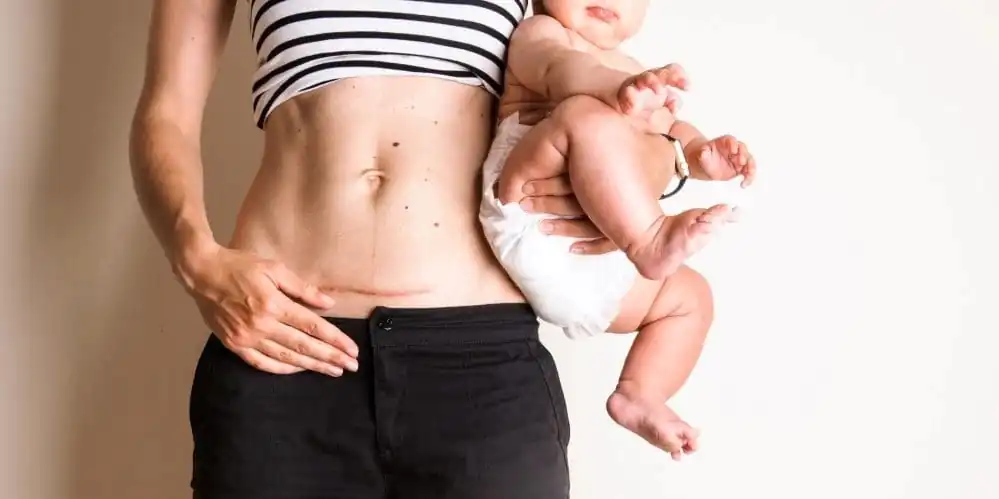
Summarizing
Despite the fact that laparoscopy is a gentle surgical method of treatment, it should be treated with the utmost responsibility.. It is necessary to give preference only to proven, qualified specialists who will not only perform a high-quality operation (laparoscopy), but also provide proper postoperative care (observation, care recommendations).
Although inflammation of the suture does not pose a threat to life, if this symptom appears in the postoperative period, it is necessary to immediately begin taking measures to relieve the inflammatory process, as this can lead to serious complications.
Found an error? Select it and press Ctrl+Enter.
6 minutes Author: Lyubov Dobretsova 28343
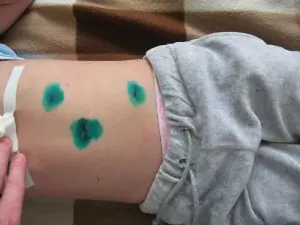
Laparoscopy refers to a low-traumatic method that is used for diagnostic and surgical purposes of organs located in the pelvic and abdominal areas. Despite all the advantages, this method, if the doctor’s recommendations are ignored, can cause certain problems in the postoperative period. One of the issues that requires increased attention is sutures after laparoscopy. Our article tells you on what day the sutures are removed, how they are processed, and how long it takes for them to heal.
When is laparoscopy indicated?
Laparoscopy is used to perform a low-traumatic operation to remove or restore the affected organ. With its help they carry out:
- removal of the gallbladder;
- appendicitis;
- kidney;
- Bladder;
- ureter;
- fallopian tubes;
- uterine cystosis;
- ectopic pregnancy;
- treat endometriosis;
- treat polycystic ovary syndrome;
- hernias;
- fibroids;
- adhesions;
- stop internal bleeding.
When do stitches heal?
Many people are interested in when sutures are removed after laparoscopy. They are usually removed 7 days after surgery. However, there are situations when sutures are removed after 2 weeks. This most often occurs in people who are overweight.
Today, self-absorbable threads are often used. They disappear on their own a week after the abdominal threads dissolve. If everything goes without complications, the scars will become invisible after 2–3 months. During pregnancy, scars after laparoscopic surgery become brighter and form stretch marks.
What is it processed with?
The seams need to be treated with antiseptic solutions, which are sold in pharmacies: hydrogen peroxide, brilliant green, alcohol-based liquid. During processing, it is better not to use cotton wool, as it can leave pieces along the edges of the seam, which can cause an inflammatory process. A gauze swab is better suited for these purposes. The ichor oozing from the wound should be a cause for concern.
The procedure for processing postoperative sutures is as follows:
- Roll up a small part of the sterile bandage, then dip it in the treatment solution and wipe the seam. Moreover, it is necessary to ensure that all the dimples are wetted. Next, let the skin dry.
- If you experience a burning sensation or pain, apply a sterile gauze bandage.
- If there is no pain, then a cotton swab dipped in brilliant green should be used to smear the seam. After which a sterile bandage is applied.
With the doctor's permission, for better healing, the wound can be left unsealed. In this case, it is important to wear loose, natural underwear that will not catch or damage the scar. After removing the stitches in this way, it is necessary to carry out treatment within a week. Many people worry whether it hurts to remove stitches. They usually don't hurt to take them off. Most often, pain is present in the presence of inflammation.
While processing seams, you should not take a bath or sauna. For hygiene procedures, it is allowed to use a shower, during which it is better to seal the scar areas with cellophane to prevent them from getting wet. Next, carry out processing in the usual way. It is necessary to carefully approach the treatment of sutures after laparoscopy. Since even minor scars can become inflamed and cause serious complications. Most often this occurs in the navel.
Signs of a normal process
The healing process of sutures may be accompanied by the following clinical picture, which often becomes a cause of concern for the patient:
- the wounds hurt with an aching character;
- moisture in the wound surface;
- abdominal bloating;
- compaction formed under the seam;
- itching
Possible complications
If the treatment was not carried out properly, then suppuration may develop. The beginning of this process is indicated by the appearance of a tumor, a hard nodule, or a lump. It is usually accompanied by pain. If leukocytosis is detected during blood donation, then the patient most likely has developed a purulent complication. In order not to miss its onset, it is necessary to inspect the wound every day during treatment for swelling and pain.
In addition, a complication in the form of suture dehiscence is possible. It usually develops due to non-compliance with the motor regime, when lifting heavy objects in the first month after surgery. To avoid this development of events, you need to follow the doctor’s recommendations; you should wear a special bandage for prevention. The inner seam may come apart as a result of flatulence. To prevent it, it is important to exclude solid, fatty foods, rich in fiber and carbohydrates, and maintain a drinking regime while the sutures are healing.
If you follow the recommendations, the possibility of seams coming apart is minimized. A special group includes diabetics, whose tissue regenerative abilities are reduced. Based on this, any wounds heal poorly. They are closely monitored with insulin therapy. If the patient has a wound infection, then he is prescribed broad-spectrum antibiotics and treated with antiseptic solutions. If the sutures come apart, they are first re-applied and the listed treatment is prescribed.
When to see a doctor
The patient should immediately consult a doctor if the following clinical picture is present:
- with long-healing sutures, which can be caused by reduced regeneration, reflection of threads by the body;
- if the wounds are very itchy as a result of irritation on the thread, bacteria, dirt, or an allergic reaction to the patch;
- swollen wounds occur when suturing technique is violated;
- the appearance of compaction, which occurs when pus, fluid accumulate, or sutures diverge;
- the seam becomes wet due to injury to the subcutaneous fat layer, infection during surgery;
- pain may occur due to suture divergence;
- discharge of ichor and fluid may be due to discrepancy if the wound is festering;
- failure to heal the wound within a week after removing the sutures indicates severe inflammation.
Sometimes there are cases when a patient requires laparoscopic intervention. Most often, the umbilical suture takes the longest to heal.
Causes of poor healing of sutures
Poor healing of laparoscopic sutures is possible for the following reasons:
- reduced immunity;
- decreased regeneration functions of the body;
- chronic diseases of the endocrine system;
- hormonal imbalance;
- excess weight;
- non-compliance with the doctor’s recommendation;
- dysfunction of muscle tissue due to old age.
Prevention of complications
To avoid the development of complications, the following preventive methods should be followed. Within 1.5 months it is necessary to remove physical activity. To avoid bacteria and infections, do not shower for 2 weeks. Swimming pool and bath are allowed every other month. Staying in the sun, visiting the bathhouse, sauna is allowed after 3 months.
Sexual intercourse is prohibited for 4 weeks. You should not eat hard-to-digest foods to prevent stretching and tension in the abdominal cavity. In order for laparoscopic sutures to heal without problems, all doctor’s recommendations should be followed. Thus, the healing process proceeds without any complications.
Surgeon, Head of the Department of Endocrine and Metabolic Surgery of the Moscow Clinical Scientific Center, Candidate of Medical Sciences, Associate Professor of the Department of General Surgery, Faculty of Pediatrics, Russian National Research Medical University named after. N.I. Pirogov.
Area of professional interests: general surgery, laparoscopic surgery, endocrine and metabolic (bariatric) surgery.



